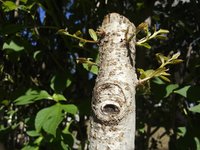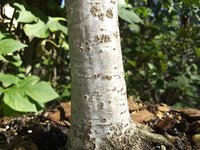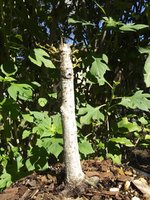SU2
Omono
In early or mid-Dec 2020 I was at H.Depot and saw a >6' Live Oak for $10 on sale so of course grabbed it despite knowing it was terrible timing, and - insult to injury - it'd need its trunk-chopping just to be taken from the H.Depot, so it got it in the parking lot & root-pruned once home.
It had 1 failed budding attempt, then basically dormant/no action through end of Dec., by early Jan it was trying again and that round had to *fight* but survived (yes it was getting brought indoors at night, artificial light / special treatment etc this wasn't left alone) and is now finally able to generate some energy of its own:

It's no coincidence it's only budding from that side so well, IE the side that gets light... but thankfully I've got some buds on the rear:
[very hard to see but 3 on the ridging around the oro cavity]
 , and a suuuuper low one very hard to see it's dead-center of this photo:
, and a suuuuper low one very hard to see it's dead-center of this photo: 
The nebari is covered-up right now but is neat. Trunk obviously never grown large enough for the classic live oak fissured-bark but still happy to have one these have proven nearly impossible to collect, this one - a nursery specimen - still had a ball of taproot I had to remove, was 'bulbous' I suspect they had used some kinda tourniquet tech, dunno, anyways today I figured it was smart to do this:
 ,
,
flipping it 180deg, so the buds on the back that're just swelling can get sun & pop -- the ones on the rear seem "ready" to have to "fight" me turning this guy 180deg, whaddya think? Would you leave it as-is, in relation to the sun? Or can those shoots handle 'arcing back to the sun' just fine? I strongly suspect the latter, hoping for thoughts as well as wanting to show my "late xmas present" since I was sooo sure he'd die I have dozens of Live Oak seedlings, since I'd never pay retail for a nursery one like this^ one, don't know why they had it at $10 but hey finally have a Live Oak to mess with
I have dozens of Live Oak seedlings, since I'd never pay retail for a nursery one like this^ one, don't know why they had it at $10 but hey finally have a Live Oak to mess with 
It had 1 failed budding attempt, then basically dormant/no action through end of Dec., by early Jan it was trying again and that round had to *fight* but survived (yes it was getting brought indoors at night, artificial light / special treatment etc this wasn't left alone) and is now finally able to generate some energy of its own:

It's no coincidence it's only budding from that side so well, IE the side that gets light... but thankfully I've got some buds on the rear:
[very hard to see but 3 on the ridging around the oro cavity]
 , and a suuuuper low one very hard to see it's dead-center of this photo:
, and a suuuuper low one very hard to see it's dead-center of this photo: 
The nebari is covered-up right now but is neat. Trunk obviously never grown large enough for the classic live oak fissured-bark but still happy to have one these have proven nearly impossible to collect, this one - a nursery specimen - still had a ball of taproot I had to remove, was 'bulbous' I suspect they had used some kinda tourniquet tech, dunno, anyways today I figured it was smart to do this:
 ,
,flipping it 180deg, so the buds on the back that're just swelling can get sun & pop -- the ones on the rear seem "ready" to have to "fight" me turning this guy 180deg, whaddya think? Would you leave it as-is, in relation to the sun? Or can those shoots handle 'arcing back to the sun' just fine? I strongly suspect the latter, hoping for thoughts as well as wanting to show my "late xmas present" since I was sooo sure he'd die

